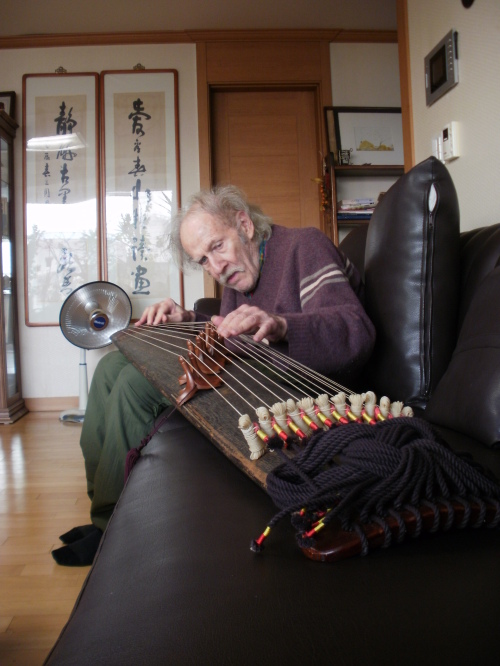Alan Heyman donates his collection of musical treasures to National Gugak Center
Most American musicians nominate the guitar, piano or drums as their favorite instrument.
But 79-year-old Alan Heyman much prefers Korean conical oboes and the 12-stringed Korean gayageum, and has dedicated his life to learning all there is to know about traditional Korean music and dance.
After more than 50 years of living in Korea and pursuing his passion for “gugak,” traditional Korean music and dance, Heyman decided late last year to donate his collection of old recorded music and rare books to the National Gugak Center in Seoul as a way of preserving the music and encouraging further study.
The collection included about 160 hours of recorded music on reel tapes which the National Gugak Center is now transferring to CDs for better storage. Some of the recordings are rare and had not been heard before.
Heyman also donated 20 old books on traditional Asian music dating as far back as the 17th century, which he had bought from secondhand bookstores while living in Insa-dong, Seoul, in the 1960s.
“All those books were written in Chinese letters, my knowledge of which is quite minimal,” said Heyman. “So I donated the books to the National Gugak Center so they could explain in Korean what the books contained, what the meaning was, and why it is significant.”
 |
Alan Heyman still enjoys playing his12-string gayageum, which is carved outof a single piece of paulownia wood andis nearly 50 years old. |
Heyman’s first taste of traditional Korean music was in 1953 as a medic in the U.S. Army during the Korean War. Stationed with a MASH unit in Gangwon province, near the 38th parallel, Heyman “had a front row seat” in what he describes as “one of the coldest places in Korea.”
“We were located next to a mountain, and on the mountain there were Chinese communist army and North Korean guerillas, and about 2 a.m. or 3 a.m. they used to play loud music over loudspeakers, using a conical oboe, gongs, drums. And when I heard the conical oboe, to me it sounded very refreshing and interesting. I believe it was a Chinese instrument, but similar to Korean.
“The other American soldiers didn’t appreciate being kept awake half the night by that loud music. But I always recall especially that conical oboe sound.”
Heyman returned home after the war to complete a master’s in music and music education at Columbia University in New York, but was disappointed to find not one Asian music course on offer anywhere in the United States.
So after graduating in 1959, Heyman moved to a small house in Insadong, Seoul, in 1960 to study and teach at the Korean Traditional Musical Arts Conservatory.
“At that time Northwest Airlines ran one flight a week. And I think, as I recall, I was the only passenger on that plane,” he said. “I didn’t know if I would be successful or not, but I decided to give it a try. My mother and father were adamant, they said ‘Don’t be ridiculous, you’re out of your mind!’”
During his first three months of adjusting to life in Seoul, and trying to learn the intricacies of entirely new instruments and music, even Heyman had his doubts and admits it wasn’t easy.
But when he became the first non-Korean to perform traditional music on stage in Korea in 1962, Heyman’s confidence grew along with his name.
“No foreigner had ever performed before, I was the first one. And the audience was flabbergasted. They couldn’t believe that they were seeing a foreigner perform Korean music.”
Heyman went on to organize the first ever tour of the United States by traditional Korean musicians and dancers in 1964, and has since toured with different troupes in a variety of roles, including to Iran, Europe and the U.S.
In between playing, learning, and teaching Korean music and dance, Heyman has also authored and translated a number of books on gugak, Buddhist rituals and Shaman rituals, and spent time teaching English at universities to support himself.
“Korean music and dance have been my life. That’s essentially what I have been living for,” said Heyman. “The problem is that it’s not very remunerative, I don’t make much money.”
Although his life of music hasn’t led to international pop fame, Heyman’s knowledge of “pansori,” traditional Korean musical theatre, did help him obtain Korean citizenship in 1995.
After being one of only two students to pass the written examination, Heyman was asked by the examiner in the oral test what he had been doing for the past 30 years in Korea.
“I said I’d been studying Korean music and dance. He said ‘Did you study pansori?’ and I said that I did. So he said ‘Tell me the story of Heungbu and Nolbu’ which I happened to know quite well, and I told the story completely and he said ‘You pass.’ So Korean music paid off quite well!”
In recent years, Heyman has focused on deepening his understanding of Korean music through reading and translating. He hopes a translation of a book on Korean Shamanism he worked on will be released this year, and plans to begin work on a history of the Korean National Folk Arts Festival soon.
“The Korean National Folk Arts Festival celebrated its 50th year last year, and I have been following it by doing video recordings and small audio recordings,” he said. “But there has never been a comprehensive, 50-year, historical translation of the festival, so that’s my plan if things work out well. But as you know, 50 years of translation is a big job. It’ll be my opus magnum.”
Heyman still enjoys playing the gayageum occasionally, and likes to play the conical oboe in the mountains in spring and summer, as it is too loud to play indoors.
By Hamish Boland-Rudder, Intern reporter
(hamish.bolandrudder@gmail.com)








